KPMG流程图绘制
- 格式:pptx
- 大小:1.32 MB
- 文档页数:43
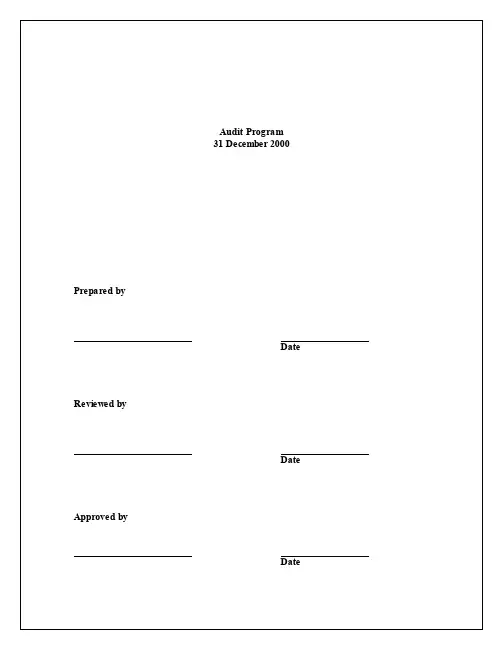
Audit Program31 December 2000Prepared byDate Reviewed byDate Approved byDateYEAR ENDAUDIT PROGRAM FOR Cash & BankRef Audit Procedures - Nature, Timing and Extent W.P. Ref. Performed by _____ 1. Compare the listing of cash and bank accounts with those of priorperiods and investigate any unexpected changes (e.g., creditbalances, unusual large balances, new accounts, closed accounts) orthe absence of expected changes._____ 2. Review interest received in relation to the average cash and bankbalances.Cash balances_____ 3. (a) Obtain a copy of the list of balances of cash as at 31/12/1999 and31/12/2000.(b) Check casting and agree total with general ledger controlaccount._____ 4. Scan cash entries noting any unusual items and make furtherinvestigation where considered necessary.Bank Balances_____ 5. (a) Obtain a copy of the list of balances of bank as at the period enddate; and(b) Check casting and agree total with general ledger control account.6. Bank Confirmation request (Note 2)(a) Get a standard bank confirmation request form from thestationery cupboard.(b) Fill in the client name, our reference number and the period oryear end date (please specify) for the bank to confirm.(c) Give the partial completed form to the relevant client staff .(d) Request the client to perform the following tasks:·Stamp the form with the company chop;·Have the form signed by an authorized signatory;·Fill in the balances in the appropriate boxes;·For items which are not applicable for the company, fill in“N/A” in the corresponding boxes; and·Confirm to us whether the form can be sent to the bank by mailor if the client is required to take the confirmation to the bank.YEAR END 31 December 2000AUDIT PROGRAM FOR Cash & Bank (Continued)Ref Audit Procedures - Nature, Timing and Extent W.P. Ref. Performed by Bank Balances (Continued)(e) Check the completed confirmation form to ensure thefollowing:·the balances agreed to the bank statements as at theconfirmation date;·the form is properly signed;·the client has filled in all security and guarantee related matterson the bank confirmation; and·Send the bank confirmation form to the bank by post.OrIf the client staff has to take the confirmation to the bank, arrange astaff to go with him/her. (Note 3)(f) Keep copies of the confirmation in the file until replies areobtained from the banks.(g) When replies are received, check the confirmations received toensure that:·the forms were stamped and signed by the bank on the lastpage; and·the individual balances and information are endorsed by thebank staff personal chop. (Note 4)_____ 7. Examine the client’s bank reconciliation as at 31/12/2000 asfollows:a) agree book balance to Cash Book and General Ledger;b)agree balance per bank statement to bank statement at theyear end and bank confirmation received;c) check casting of the bank reconciliation;d)vouch all lodgments / lodgments with amount greater thanRMB _____ * not clear to the cash book and bank statementin the following month ensuring all lodgments are cleared;(Note 5)e) vouch all outstanding cheques / outstanding cheques withamount greater than RMB _____ * to the cash book and to thebank statement in the following month & note down the datewhen they are cleared; (Note 5)f) obtain explanations from the client of all outstanding lodgments/ lodgment with amounts greater than RMB_____ *;g) investigate all stale cheques / stale cheques with amountgreater than RMB_____ * issued for more than five / ten days*, and make appropriate adjustments thereof in the cash bookand ledger; (Note 6)YEAR END 31 December 2000AUDIT PROGRAM FOR Cash & Bank (Continued)Ref Audit Procedures - Nature, Timing and Extent W.P. Ref. Performed by Bank Balances (Continued)h) investigate all payments / payments with amount greater thanRMB_____ * recorded by the bank but not recorded by theclient, and make appropriate adjustments thereof in the cashbook and ledger; (Note 6) andi) investigate all receipts / receipts with amount greater thanRMB_____ * recorded by the bank but not recorded by theclient, and make appropriate adjustments thereof in the cashbook and ledger. (Note 6)_____ 8. Review the bank book for any unusual items (greater than RMB_____) such as: a) non-trading receipts or payments andb) transfers in and out of the bank accounts._____ 9. Select receipts larger than RMB ______ and payments larger thanRMB ______ within ____weeks before and after the year end toensure that they have been properly accounted for.General_____ 10. Review the cash and bank accounts in the general ledger for unusualitems._____ 11. Review the cash disbursements and cash receipts registers forunusual items; investigate any such items observed._____ 12. Review bank confirmations, minutes, loan agreements and otherdocuments for evidence of restrictions on the use of cash, or ofliens, or security interests in, cash._____ 13. Consider the covenants and other narratives given in loan and othermaterial agreements and determine compliance with the agreementsand whether necessary disclosure have been made._____ 14. Consider the implications of client management practices that resultin recurring short term loan to finance working capital. Considerinquiry of client management and alert your senior / executiveshould such short term loans be encountered in the audit.YEAR END 31 December 2000AUDIT PROGRAM FOR Cash & Bank (Continued)Ref Audit Procedures - Nature, Timing and Extent W.P. Ref. Performed by* Delete as appropriateNote 1i. The cash count should be performed by cashier with the presence of a staff that normally is not involved in the cashier function.ii. Cash certificate is acceptable only if the petty cash balance is considered as immaterial and / or the risk associated is low/ minimal.Note 2i. Bank confirmations are sent on an individual branch basis, i.e. one confirmation per branch.ii. Confirmation should also be sent to accounts closed during the year.iii. If either the bank or the client refuses to reply/send the confirmation, consider if there is a significantlimitation of our audit scope and its implications.Note 3When it is not feasible for an EYHM staff to go with the client, we must reconsider if the confirmation obtained provides sufficient and reliable audit evidence due to the lack of independence.Note 4Alternatively, the bank may issue its own bank certificate to confirm the deposits and loans balances and confirm that no other business transactions exiting.Note 5The extent of vouching work depends on our assessment of the likelihood of errors occurring.Note 6We have to consider the effect in aggregate regarding the unadjusted items which are below the amount stipulated in this procedure whenever one is set.YEAR END 31 December 2000AUDIT PROGRAM FOR Accounts ReceivableRef Audit Procedures - Nature, Timing and Extent W.P. Ref. Performed by1. Obtain or prepare a listing of accounts receivable and investigateunusual balances. Credit balances, and accounts that may not beaccounts receivable, or may not be properly classified as accountsreceivable trade (e.g. consignment accounts, related-party oremployee accounts ).2. Trace the total in the customers’ ledger to the general ledger controlaccount: investigate reconciling items greater than ¥________ andunusual items.3. Compare current period’s receivables as a percentage of net sales withprior periods’ percentages. Compare discounts, returns, andallowances with prior periods (e.g. as 5 - 10% of sales).4. As of 31/12/2000, perform confirmation procedures for accounts asfollows:a. Select key items (accounts greater than ¥________ and accountswith the following characteristics: long aging, or involved in legalcase) for positive confirmation procedures.b. Using a MUS or Random technique, select a representative sampleor account (as determined through use of Audit Risk Table__________) for positive / negative confirmation procedures.c. Trace information (i.e.. balance and addresses) from individualrequests to the subsidiary records. Send requests and prepareconfirmation statistics.d. Trace confirmation replies to the trial balance and request theclient to reconcile differences. Investigate explanations for differencesgreater than ¥_______ and any unusual explanations.e. Send second requests for all unanswered positive confirmationrequests.f. Examine subsequent cash receipts, shipping records, salescontracts, and other evidence to substantiate the validity of accountsfor which no reply or an unsatisfactory reply was received.g. Summarize the results of the confirmation procedures.5. Test sales cut-off for service rendering greater than ¥ for theLast days before year end and the first ___days after yearend.Determine that the sales were recorded in the proper periodthrough review of shipping documents, billings, sales register andother supporting documents.YEAR END 31 December 2000AUDIT PROGRAM FOR Accounts Receivable (Continued)Ref Audit Procedures - Nature, Timing and Extent W.P. Ref. Performed by6. Test for out-of-period credit memos by examining those greater than¥_____ issued for the period from the balance sheet dated to/ /2001. Inquire as to whether there are any unissued credits thatrelate to the period under audit.7. Test the aging of accounts receivable and unbilled contracts foramounts greater than ¥and accounts with the followingcharacteristics: opening receivable balance brought forward from // , to support the accuracy of the aged trial balance. Trace thedetails to and from the customer’s ledger accounts or supportingdocumentation.8. Compare aging, bad debt expense, and write-offs with prior periods.Compare the current period’s accounts receivable turnover and/ornumber of day’s sales outstanding with prior periods’ amounts.9. Evaluate the adequacy of the allowance for doubtful accounts and therelated provision as follows:a. From the aged trial balance as of 31/12/2000, select accounts withbalances greater than ¥, accounts greater than ¥ that are more than180 days past due, and accounts with legal contingencies.b. In addition to those accounts selected in a above, select anyadditional accounts that have a higher likelihood of error (e.g.. prioryear experience, industry concentration).c. For those accounts selected, discuss collectibles concerns with thecredit manager or other responsible individual and reviewcorrespondence files or other relevant data in support of the client’srepresentations.d. Review subsequent collections for those accounts selected forevaluation.e. Determine if any product related problems (e.g.. quality right ofreturn) are affecting collectibles and should be considered indetermining the adequacy of the allowance. These problems shouldalso be considered in determining the adequacy of the allowance forinventory obsolescence.f. Perform appropriate analytical review procedures.g. Conclude on the adequacy of the allowance.10. Review the accounts receivable and sales accounts in the generalledger and the sales and cash receipts registers for unusual items:investigate any such items observed.11. Determine whether any receivables are pledged as collateral orSubject to any liens; coordinate with work on debt payable.CLIENT .YEAR END 31 December 2000AUDIT PROGRAM FOR Prepayment & Construction in ProcessRef Audit Procedures - Nature, Timing and Extent W.P. Ref. Performed by _____ 1. Obtain or prepare an analysis for each significant classification ofprepaid expenses, deferred charges, other assets or intangibles.Include adequate descriptions of significant components and thefollowing:a. Balance at the beginning of the periodb. Additions at costc. Deductions charged to expense, and to other accountd. Balance at the end of the period._____ 2. Foot the analyses and trace totals to the general ledger: trace thebeginning balances to the prior period audit working papers._____ 3. Compare the account balances with those of prior periods andinvestigate any unexpected changes (or the absence of expectedchanges). For accounts greater than ¥and accounts that have changedby the greater of ¥ or 5~10% from the prior period. Recomputed theending balance (and examine supporting documents for significantcharges as appropriate) and determine that the carrying amount doesnot exceed amounts properly allocable to future periods._____ 4. Trace amounts amortized to expense during the period to the relatedgeneral ledger accounts._____ 5. Confirm deposits and assets held by others for those items greaterthan ¥ and items related to construction of shelters and unipoles, oritems related to operating expenses for sales centers._____ 6. Review the accounts under this classification and the related incomeand expense accounts in the general ledger for unusual items:investigate any such items noted._____ 7. Determine that there has been no permanent impairment of value fordeferred charges, intangible assets, etc._____ 8. Determine that balances are properly classified in the balance sheet(current versus non-current, etc.).____ 9. Identify any exceptional item (i.e. prepaid legal fee). Investigate itsnature and consider the recoverability of these items and whether anyprovision is needs.10. Perform reasonableness test on amortisation of deferred expenses._____ 11. Send and obtain confirmations from staff and sales centers to verifyexistence of assets._____ 12. Perform overall analytical review on total prepayment andconstruction in progress._____ 13. Obtain and review a movement of construction in progress, examinesupporting documents for material additions.14. Test the calculation of capitalised interest if appropriate.____ 15. Check Completion Verification to ensure that CIP is transferred tofixed assets at proper time.CLIENTYEAR END 31 December 2000AUDIT PROGRAM FOR AffiliatesRef Audit Procedures - Nature, Timing and Extent W.P. Ref. Performed by ______ 1. Review other receivable and payables, and reclassify currentaccounts with ultimate holding company, subsidiaries, fellowsubsidiaries and associate company to the proper accounts.______ 2. Agree or reconcile all current accounts balance with relatedparty by sending confirmation. Agree the current accountbalance with subsidiaries’ books and records.CLIENT .YEAR END 31 December 2000AUDIT PROGRAM FOR Fixed Assets and Concession RightsRef Audit Procedures - Nature, Timing and Extent W.P. Ref. Performed by ______ 1. Obtain or prepare a summary of property, plant and equipment andrelated depreciation (by major classification) including thefollowing:a. Beginning and ending balances at cost.b. Asset additions at cost.c. Asset retirements and dispositions.d. Other changes (e.g. transfers).e. Beginning and ending balances of the allowances fordepreciation.f. Additions to the allowance for depreciation accompanied by ananalysis of amounts charged to expense, absorbed in inventory,and capitalized.g. Reductions of the allowance for depreciation for retirements anddispositions.______ 2. Obtain or prepare a schedule of asset additions during the period,including description, date acquired, estimated useful life, and cost,for all additions of ¥or more, with those under that amountcombined so the total additions ties to the summary schedule byclassification. Compare the level of property acquisitions for theperiod with the prior period.______ 3. Obtain or prepare a schedule of retirements and dispositionincluding description, date of acquisition, date of retirement ordisposition, cost, accumulated depreciation, net carrying value,proceeds of disposition, and gain or loss on disposition.______ 4. Trace the beginning balances per the summary schedule to endingbalances per the prior period’s audit working papers.______ 5. Trace amounts per the summary schedule to the general ledger, thedetailed asset records, and to the schedules of additions, andretirements and dispositions; test the footings and crossfootings ofthe schedules.______ 6. For asset additions greater than ¥ and additions with the followingcharacteristics: capitalised interests, or capitalised legal fees,examine supporting documents (purchase contracts, paid checks,vendors’ invoices) to verify recorded cost. Challenge the estimateduseful lives assigned.______ 7. For asset retirements and dispositions with net carrying valuesgreater than ¥, examine supporting documents (bills of sale,contracts, copies of checks) to verify proceeds and determine thatthe appropriate cost and accumulated depreciation were removedfrom the accounting records. Recomputed gain or loss.YEAR END 31 December 2000AUDIT PROGRAM FOR Fixed Assets and Concession Rights (Cont’d)Ref Audit Procedures - Nature, Timing and Extent W.P. Ref. Performed by _____ 8. Examine support for charges greater than ¥to repair andmaintenance expense accounts for potential items that should havebeen capitalized. Compare repair and maintenance expense accountbalances with the prior period and investigate any unexpectedchanges (or the absence of expected changes)._____ 9. Perform physical inspection of selected shelters in 3 major citiesand determine asset recoverability / realization._____ 10. Note down the depreciation policy under the Group’s instruction.Perform reasonableness test or detail recalculations to assessdepreciation / amortization expense and tie the total expense perthe property summary to the general ledger accounts._____ 11. Obtain or prepare schedules of lease and rental expense detail.Examine support for charges greater than ¥________ to determineproper classification. Determine that any new leases have beenproperly accounted for._____ 12. Test the calculation of capitalized interest, if appropriate._____ 13. Review the property, plant and equipment and related accounts inthe general ledger for unusual items; investigate such items noted._____ 14. Review minutes, agreements, UCC filings, and other documents(e.g., bank and loan confirmations) for evidence of liens, pledges,security interests, and restrictions on property, plant andequipment._____ 15. Determine the tax basis of accounting for property, plant andequipment transactions, and verify that any book-tax differenceshave been accounted for property.YEAR END 31 December 2000AUDIT PROGRAM FOR Accounts Payable, Accruals and Other LiabilitiesRef Audit Procedures - Nature, Timing and Extent W.P. Ref. Performed by ______ 1. Obtain or prepare a schedule of accounts payable details as of thebalance sheet date: foot the schedule and trace the total to theaccounts payable balance in the general ledger.______ 2. Compare the list of accounts payable with those of prior periodsand investigate any unexpected changes (e.g. changes in majorvendors, in the proportion of debit balances, in the aging of theaccounts, etc.) or the absence of expected changes.______ 3. Review the accounts payable account in the general ledger andsupporting detail for unusual items. Investigate debit balancesand , if significant, consider requesting positive confirmations andpropose reclassification of amounts.______ 4. Obtain or prepare a schedule of accrued liabilities and deferredincome. Examine the composition and the computation of thoseaccounts considered significant or whether the change / lack ofchange in lance from the prior period is unexpected.______ 5. Compare the account balances with those of prior periods andinvestigate any unexpected changes (or the absence of expectedchanges).______ 6. Ensure the provision of welfare fund and staff welfare expensesare properly accrued and accounted for.______ 7. Review construction contracts and related documents for anyunrecorded liabilities and make adjustments if necessary.______ 8. Circularise the payable accounts with material balances.______ 9. Agree payable accounts with material balance to suppliers’statements or vouch to customer receipts, if available.______ 10. Perform a search for unrecorded liabilities at the year end byreviewing disbursements voucher and unpaid invoices overRMB after year end.YEAR END 31 December 2000AUDIT PROGRAM FOR Tax payableRef Audit Procedures - Nature, Timing and Extent W.P. Ref. Performed by ______ 1. For detailed procedures, please see PRC TA X PROVISIONAUDIT PROGRAMME.YEAR END 31 December 2000AUDIT PROGRAM FOR Short Term Bank LoansRef Audit Procedures - Nature, Timing and Extent W.P. Ref. Performed by _____ 1. Obtain or prepare a schedule and a movement of bank loan andrelated interest accounts by issue showing the following:Description (date of origin, type of debt, maturity, face amount,interest rate, timing and amount of payments): Activity in theprincipal and related interest accounts (beginning balance,additions, payments, ending balance)._____ 2. Test the clerical accuracy of the schedule in #1 above, and tracetotals to the general ledger. Compare the account balances withthose of prior periods and investigate any unexpected changes (orthe absence of expected changes)._____ 3. Confirm all debt account, including those paid off during theperiod, as of 31/12/2000. Information to be confirmed shouldinclude: principal and related interest due at end of period, terms,liens, security interests or assets pledged as collateral, andcompliance with covenants._____ 4. Test interest paid and accrued and tie expense to the trial balance.Perform an overall test of the reasonableness of interest expense bymultiplying the average interest rate by the average amount of debtoutstanding._____ 5. Vouch to supporting documents (bank-in slip etc.) to ensure thatrepayments have been made as expected and the year end balance iscorrect and correctly disclosed._____ 6. Obtain and review copies of all new debt agreements and anyexisting debt agreements for which we do not have a copy in ourfiles. Review to determine the terms, restrictions, and otherpertinent provisions of long-term debt._____ 7. Determine whether receivables, inventory, and / or property, plant,and equipment are pledged as collateral or subject to any liens._____ 8. Review short-term / long-term classification of debt for propriety.YEAR END 31 December 2000AUDIT PROGRAM FOR Share capitalRef Audit Procedures - Nature, Timing and Extent W.P. Ref. Performed by _____ 1. Obtain or prepare an analysis of all equity accounts progressingform the beginning of the period to the end of the period. Test theclerical accuracy of the analysis. Trace the beginning balances toprior period audit working papers and trace ending balances to thegeneral ledger._____ 2. Examine support for and determine the propriety of accounting forany changes in the equity accounts from the prior period._____ 3. Review minutes or other supporting documents for theauthorization for and the details of transactions that affected theequity accounts during the period._____ 4. If the company does not keep itsown stock record books:a.Obtain confirmation of shares outstanding from the registrarand transfer agent.b. Reconcile the schedule to the general ledger._____ 5. Analysis activity in the retained earnings account during the period;trace the beginning balance to the prior period audit wordingpapers; trace the ending balance to the general ledger; trace incometo the financial statements and support other changes asappropriate._____ 6. Obtain the calculation sheets of minority interests (MI) and reviewit. Ensure that all proposed adjustment related to retained earningsare also affect the results of MI.YEAR END 31 December 2000AUDIT PROGRAM FOR Commitments (承付)and contingenciesRef Audit Procedures - Nature, Timing and Extent W.P. Ref. Performed by _____ 1. Review all contracts and agreements to determine the capitalcommitment(未来的资本性支出-已承诺支付)._____ 2. Inquire management and check board minutes, bank confirmations,contracts, loan agreements, leases and correspondence withsolicitors for indications of other guarantees, commitments orcontingencies.YEAR END 31 December 2000AUDIT PROGRAM FOR RevenueRef Audit Procedures - Nature, Timing and Extent W.P. Ref. Performed by _____ 1. Obtain or prepare a comparative analysis of sales (by productline, division, etc.) and other income accounts for the current andpreceding period and investigate acoounts that changed by thegreater of ¥ or 10%._____ 2. Select 20-25 sales transactions from throughout the period andsupport proper recording by comparing sales invoice information toshipping documents and tracing the invoice through the accountingsystem to recording the general ledger._____ 3. See Accounts Receivable step #10._____ 4. Review the other non-current credit accounts in the general ledgerfor unusual items._____ 5. Perform additional analytical review procedures as follows:See Accounts Receivablestep #3._____ 6. Refer to Accounts Receivables for the procedures relating to testsof cut-off of sales invoices and credit memos._____ 7. Examine support for the charges to the other non-current creditaccounts during the period._____ 8. Account for and test the numerical sequence of sales invoice and /or photos that is for completeness.YEAR END 31 December 2000AUDIT PROGRAM FOR Cost and ExpensesRef Audit Procedures - Nature, Timing and Extent W.P. Ref. Performed by _____ 1. Obtain or prepare a comparative analysis of expense accounts(grouped by income statement classification ) and investigateaccounts that fluctuated by the greater of ¥or 10~20%. Alsocompare each classification of expenses as a percentage of net saleswith prior period percentages and investigate unexpected changes(or the absence of expected changes).注意各项与sales的比重变化,因为有可能其本身的变化来自sales的增或减_____ 2. Review the expense accounts in the general ledger and thepurchases journal for unusual items; investigate any such itemsobserved.注意采购成本被纳入费用_____ 3. Perform monthly analysis of salries, and identify any sales bonus orcommission to assess reasonableness._____ 4. Perform reasonableness test on the following items:a.shelters’ rental, electricity and subcontractors expensesbased on the fluctuation of shelters quantity.b.rental expenses for head office and sales centres.c.interest income._____ 5. Test any irregular items in “others” obtain adequate supportingdocuments and perform analysis._____ 6. Consider any commitment arisen from those rental contracts forshelters in each city and from those lease contracts for premises.。
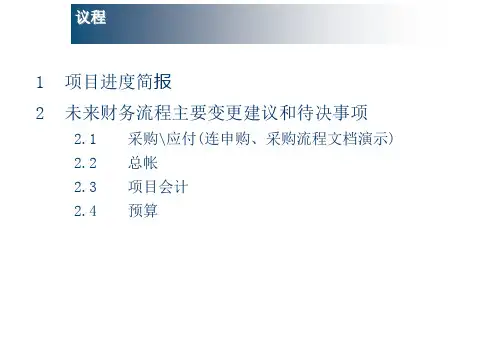
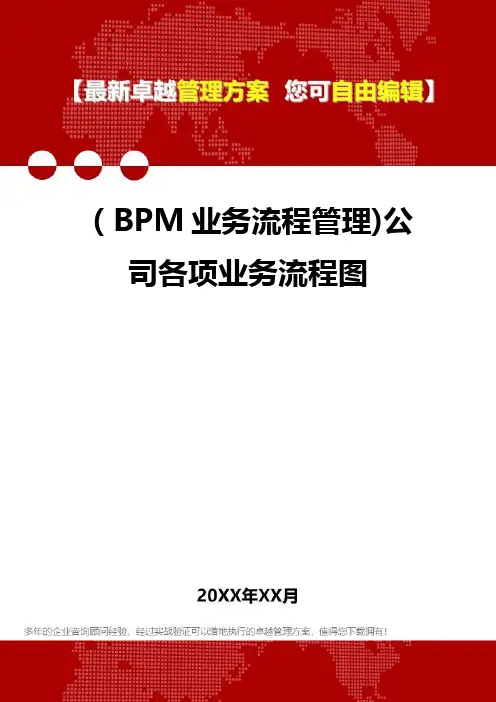
(BPM业务流程管理)公司各项业务流程图行政人事管理流程入职流程表请假流程表出差流程图部门总监或总经理专项档案管理流程相关部门相关领导重要档案借阅管理流程相关部门人力行政部相关领导行政管理中心公文(发文)管理流程相关领导行政管理中心相关部门招聘管理流程财务总监审核不合格不同意合格财务管理流程费用报销管理流程相关部门按财务规范填写和粘贴票据通过否通过资产购置管理流程相关部门通过 小型资产 大型资产 通过通过大型资产 通过资产调用管理流程相关部门通过资产处置管理流程相关部门资产盘点管理流程相关部门财务部否通过 通过财务部资金流出管理流程相关部门项目成本计划编制流程工程造价、运营拓展部工程项目总承包招标管理流程运营拓展部/工程管理部选定供应商(接上页)监理招标管理流程运营拓展部/工程管理部分包工程招标管理流程运营拓展部/工程管理部运营拓展部/工程管理部甲定乙供材料与设备定价管理流程运营拓展部/工程管理部工程合同管理流程相关部门工程管理部/运营拓展部相关领导工程管理部/运营拓展部注释:单项工程变更金额超过5万元的,视为重大工程变更。
工程款中期支付管理流程工程管理部/运营拓展部工程管理流程方案设计管理流程工程管理部施工图设计管理流程工程管理部相关部门工程管理部相关领导工程管理部工程进度与计划管理流程工程管理部质量缺陷修补及质量事故处理流程工程管理部质量缺陷单位工程竣工验收管理流程工程管理部材料检验管理流程工程管理部。
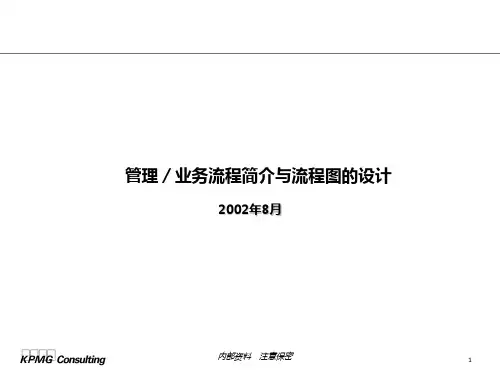
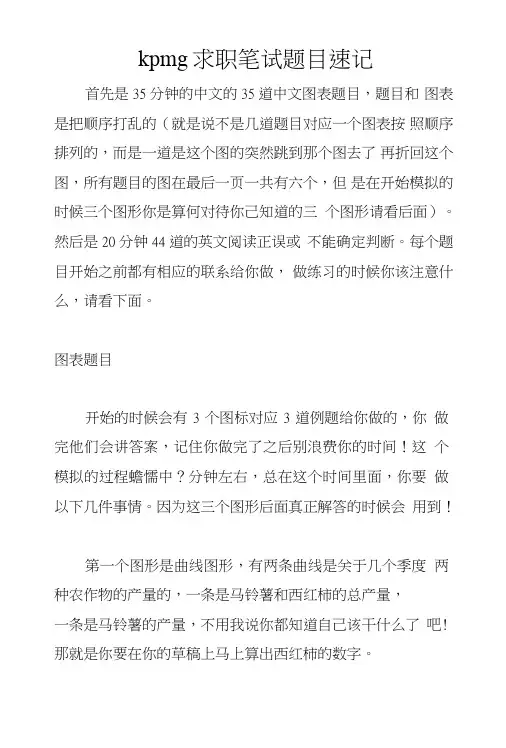
kpmg求职笔试题目速记首先是35分钟的中文的35道中文图表题目,题目和图表是把顺序打乱的(就是说不是几道题目对应一个图表按照顺序排列的,而是一道是这个图的突然跳到那个图去了再折回这个图,所有题目的图在最后一页一共有六个,但是在开始模拟的时候三个图形你是算何对待你己知道的三个图形请看后面)。
然后是20分钟44道的英文阅读正误或不能确定判断。
每个题目开始之前都有相应的联系给你做,做练习的时候你该注意什么,请看下面。
图表题目开始的时候会有3个图标对应3道例题给你做的,你做完他们会讲答案,记住你做完了之后别浪费你的时间!这个模拟的过程蟾懦中?分钟左右,总在这个时间里面,你要做以下几件事情。
因为这三个图形后面真正解答的时候会用到!第一个图形是曲线图形,有两条曲线是关于几个季度两种农作物的产量的,一条是马铃薯和西红柿的总产量,一条是马铃薯的产量,不用我说你都知道自己该干什么了吧!那就是你要在你的草稿上马上算出西红柿的数字。
你要算的东西如下:(假设总体分别是70,75。
)西红柿:5060.....(这一行是根据总数减去马铃薯的数量得出来的)马铃薯:20 15 .... (这一行是己经知道的)你只要列出两行的数字就可以了,以后会有用的。
第二个是数字列表,是关于男女各个的年龄阶段的剩余年龄,叫你推算出其可以活的总岁数。
记得算出男女的总岁数,列两行数字,以后会有用的。
题目如下:年龄男剩余岁数女剩余岁数08 37857 867206 7575 03040你要算的数据如下:年龄男共活女共活58372(就是从这一行开始你要加上已经有的年龄!)第三个图表是关于几年间的通货膨胀率和香蕉价格指数之间的关系,你只要知道两者是正相关就可以了,就是通货膨胀率越高价格越大。
你要做的事情就是快速用你的计算器算出各自的上升后的最终价格。
题目如下:年份通货膨胀率香蕉价格指数你要算的价格(试卷上没有的)1987年8%1 2 0(这个或者是12 0*( 1+8%)或107*(1+8%)我不确定,不负责,自己算好了,以上是你在人家做例题阶段应该做的事情,如果你都做了,那么你起码可以节省5分钟的时间出来,这些时间足够你应付以后的那三个图标了。
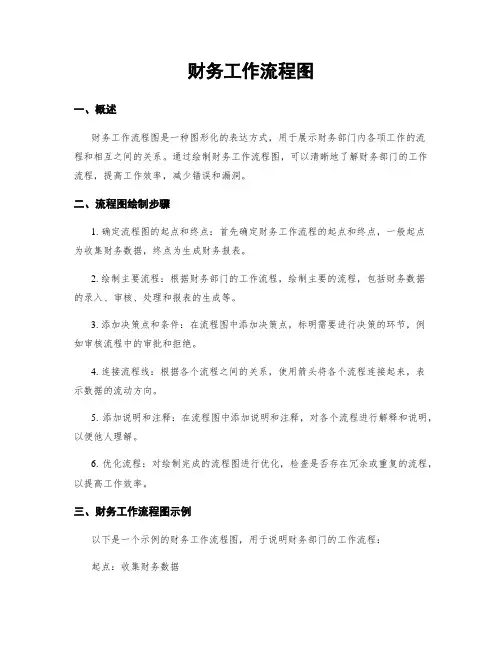
财务工作流程图一、概述财务工作流程图是一种图形化的表达方式,用于展示财务部门内各项工作的流程和相互之间的关系。
通过绘制财务工作流程图,可以清晰地了解财务部门的工作流程,提高工作效率,减少错误和漏洞。
二、流程图绘制步骤1. 确定流程图的起点和终点:首先确定财务工作流程的起点和终点,一般起点为收集财务数据,终点为生成财务报表。
2. 绘制主要流程:根据财务部门的工作流程,绘制主要的流程,包括财务数据的录入、审核、处理和报表的生成等。
3. 添加决策点和条件:在流程图中添加决策点,标明需要进行决策的环节,例如审核流程中的审批和拒绝。
4. 连接流程线:根据各个流程之间的关系,使用箭头将各个流程连接起来,表示数据的流动方向。
5. 添加说明和注释:在流程图中添加说明和注释,对各个流程进行解释和说明,以便他人理解。
6. 优化流程:对绘制完成的流程图进行优化,检查是否存在冗余或重复的流程,以提高工作效率。
三、财务工作流程图示例以下是一个示例的财务工作流程图,用于说明财务部门的工作流程:起点:收集财务数据1. 财务数据录入:将收集到的财务数据录入财务系统。
2. 财务数据审核:审核录入的财务数据,确保数据的准确性和完整性。
3. 财务数据处理:根据审核后的财务数据进行相应的处理,例如计算利润、成本等。
4. 财务报表生成:根据处理后的财务数据生成财务报表,如资产负债表、利润表等。
5. 财务报表审核:审核生成的财务报表,确保报表的准确性和合规性。
6. 财务报表分发:将审核通过的财务报表分发给相关部门和管理层。
终点:生成财务报表四、注意事项1. 流程图应该简明扼要,不要过于复杂,以便他人能够快速理解。
2. 在绘制流程图时,应该注意流程之间的逻辑关系,确保流程的顺序和逻辑的正确性。
3. 流程图应该根据实际情况进行定制,不同企业的财务工作流程可能有所不同,需要根据实际情况进行调整和修改。
4. 在绘制流程图时,可以使用专业的绘图工具,如Microsoft Visio等,以便更好地展示流程图。
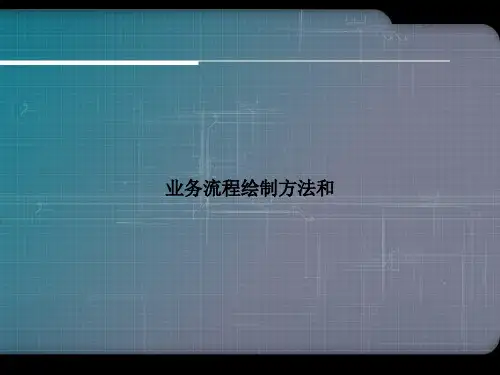

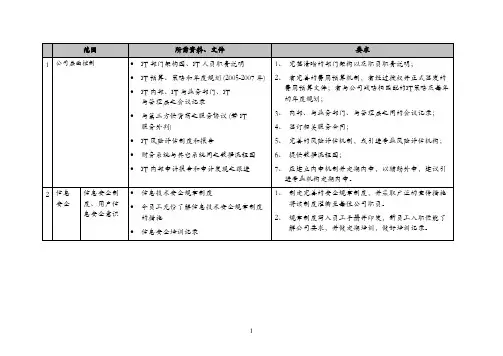
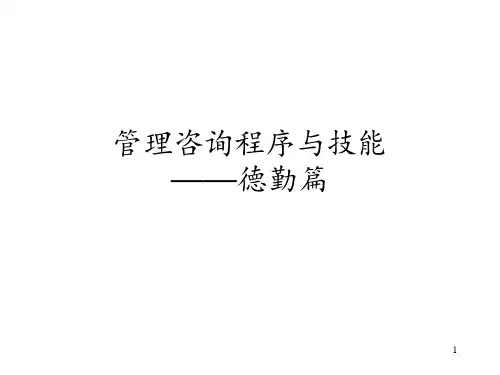
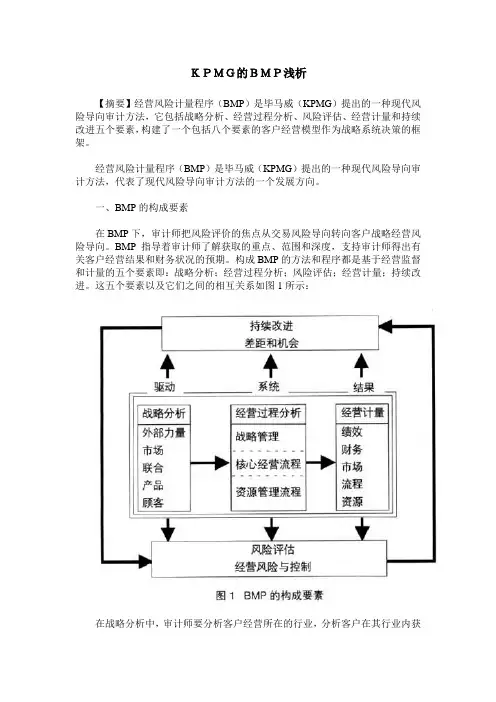
KPMG的BMP浅析【摘要】经营风险计量程序(BMP)是毕马威(KPMG)提出的一种现代风险导向审计方法,它包括战略分析、经营过程分析、风险评估、经营计量和持续改进五个要素,构建了一个包括八个要素的客户经营模型作为战略系统决策的框架。
经营风险计量程序(BMP)是毕马威(KPMG)提出的一种现代风险导向审计方法,代表了现代风险导向审计方法的一个发展方向。
一、BMP的构成要素在BMP下,审计师把风险评价的焦点从交易风险导向转向客户战略经营风险导向。
BMP指导着审计师了解获取的重点、范围和深度,支持审计师得出有关客户经营结果和财务状况的预期。
构成BMP的方法和程序都是基于经营监督和计量的五个要素即:战略分析;经营过程分析;风险评估;经营计量;持续改进。
这五个要素以及它们之间的相互关系如图1所示:在战略分析中,审计师要分析客户经营所在的行业,分析客户在其行业内获取持续竞争优势的战略,分析对战略的成功实施造成威胁的经营风险以及客户对这些风险的反应。
在战略分析中,审计师对下列事项做出判断:客户是否具有占领当前市场领域的优势?外部力量是否对这些领域造成了威胁,以及根据客户的战略定位来看,会计选择是否适当?在经营流程分析中,审计师分析客户组织的关键经营流程,作为一种对构成每一流程的作业流、流程之间以及流程与个人和主体外的组织之间如何发生相互联系以及那些决定了这些相互联系强度的能力和竞争优势逐步获得广泛了解的手段。
在经营流程分析中,审计师识别重大的流程风险,逐步了解他们是如何被控制的。
审计师采用流程绩效的计量方法来识别客户流程与表现出相同流程优势的直接竞争者的类似流程之间的差距。
而且,审计师要获得对用来管理组织关键经营流程绩效的重要关键绩效计量方式的了解,并考虑这些计量方式在何种程度上可以用来作为确证性证据,来支持其对财务报表认定的预期。
在风险评估中,审计师要了解客户的风险管理流程,以及客户在多大程度上监督了那些对整体经营目标和经营流程目标的实现造成威胁的风险。
管理业务流程怎么画在现代商业环境中,管理业务流程的重要性愈发凸显。
一个清晰而高效的业务流程图能够帮助企业提升运营效率,优化资源配置,增强团队沟通协作,从而取得更好的业绩。
那么,在实际操作中,我们应该如何画出一份符合实际需求的管理业务流程图呢?1. 确定流程范围在进行业务流程图绘制之前,首先需要明确所要展现的流程范围。
这包括整个业务流程的起始点和终点,以及每个环节中的具体步骤和关键决策点。
确定清晰的流程范围有助于避免在后续的细节设计过程中出现混乱。
2. 收集信息和记录流程在明确流程范围后,第二步是收集相关信息。
这包括与业务相关的文件、数据、人员和相关资料。
通过与相关岗位人员进行沟通,了解业务流程的具体执行步骤和所需的资源。
在此基础上,可以开始逐步记录流程,包括主要活动、决策点、输入、输出等内容。
3. 使用流程图工具绘制选择适合的流程图工具进行绘制是非常重要的一步。
流程图可以采用各种形式,如流程图、时序图、数据流程图等,选择一个合适的工具可以让绘制过程更加高效和规范。
在绘制过程中,需要确保流程图的层次清晰,符号统一,文字简洁明了,便于阅读和理解。
4. 审核和优化完成初步绘制后,需要邀请相关部门和人员进行审核。
他们可以从不同角度审视流程图,发现其中可能存在的问题或改进的空间。
在审核和反馈的基础上,及时对流程图进行修改和优化,确保其与实际业务运作相符合并具备实际可行性。
5. 沟通和培训最后一步是将绘制完成的管理业务流程图进行沟通和培训。
向相关员工和团队介绍新的流程图,说明其背后的逻辑和意义,培训他们如何按照流程执行工作。
通过全员的参与和理解,将管理业务流程图真正落地,提升整体业务运营的效率和质量。
综上所述,管理业务流程图的绘制是企业管理中的一项重要工作,需要充分的准备和仔细的规划。
通过确立流程范围、收集信息、使用流程图工具绘制、审核和优化以及沟通和培训等多个步骤,可以帮助企业建立清晰、高效的业务流程,提升管理水平和团队执行力,实现业务目标的持续增长。